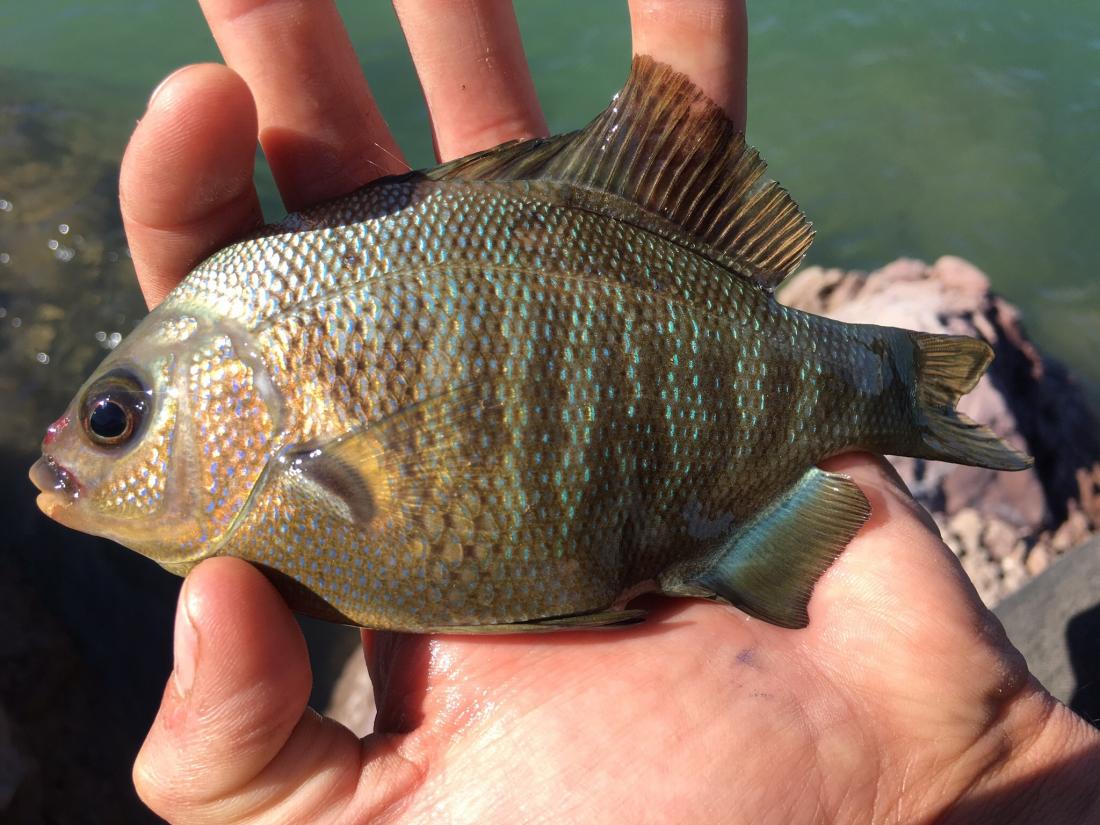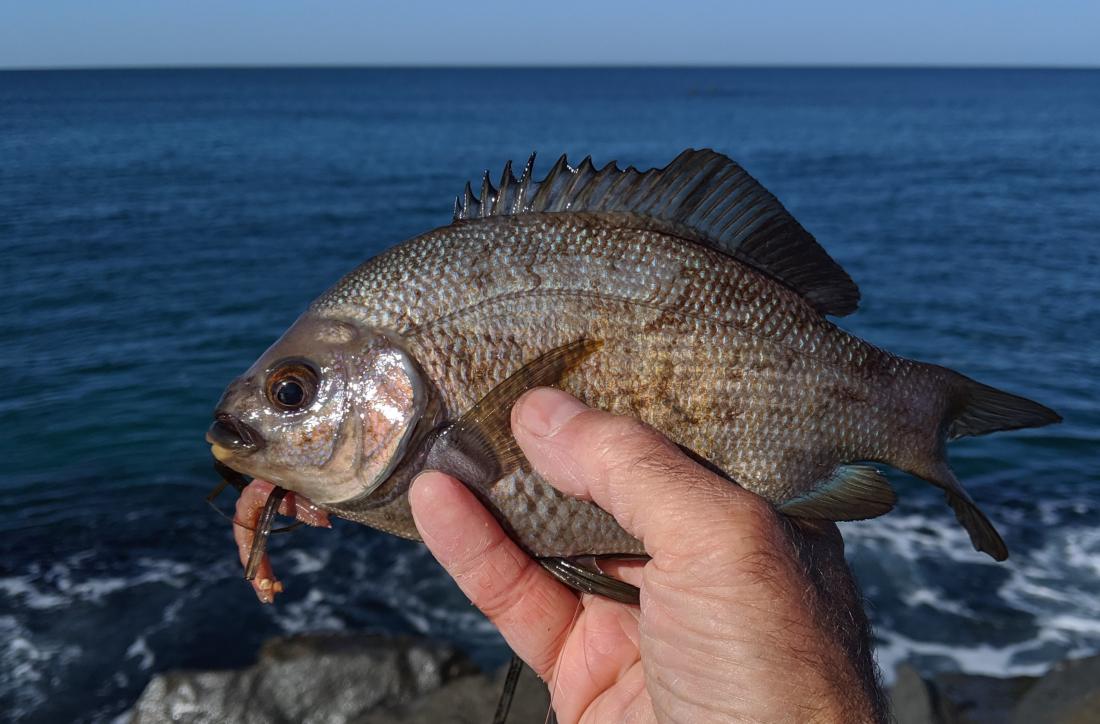Black Perch
Embiotoca jacksoni
The Science
THE SCIENCE
This fish ranges in color, but is rarely (if ever) actually black!

Taxonomic description
- Has a compressed, oval body and ranges in color from silvery, orange-brown, light tan, to greenish white, depending on the substrate color that it can blend with. [1]
- Has thick orange or yellow lips, and sometimes has shading above the upper lip that looks like a mustache. [1]
- Adults average 15.24cm (6 inches) but can grow up to 38.1cm (15 inches and weight 2 kg (4.5 lbs). [1]
Distribution
- Found along the coast of Northern California to Central Baja California, but is mostly south of Central California. [1]
Life history
- Matures at 1-2 years, and can live 6-9 years. [1]
- Fertilized eggs are hatched prematurely in females, and the embryos continue to incubate in the mother for another 12 months until she gives live birth! [1]
- The number of offspring increases with the age of the female, and she can have about 30 young at a time. [1]
Habitat
- Lives in shallow waters, and prefers depths of 0.9m (3 ft), and is often found in the surf zone. [1]
- Associated with rocky or sandy substrate, kelp forests, near piers, and in eelgrass within estuaries. [1]
- Predators of the black perch include harbor seels, cormorants, and humans. [1]
- Preys on amphipods, crabs, brittlestars and worms. [1]
The Fishery
THE FISHERY
The black perch is a popular fish for recreational anglers, and is available year-round!.

Seasonal availability
- Available for recreational fishing year-round! [2]
- The commercial surfperch fishery has a seasonal closure from May 1 through July 31. [4]
Regulatory and managing authority
- As established by the Marine Life Management Act, the California Fish and Game Commission regulates the fishery, and the California Department of Fish and Wildlife manages this fishery. [14j]
Gear type
- Typicaly caught by hook-and-line anglers along beaches, bays, and piers. [3,4]
- Other commercial methods involve A-frame dip nets, beach seines. Perch are caught incidentally with round haul nets and trawl gear. [4]
- Tips on when and how to fish for all surfperch fish are available at the California Department of Fish and Wildlife. [3]
Status of the fishery
- As of 2011, annual commercial landings have been decreasing, but recreational landings have remained relatively stable. Commercial declines are likely in part due to changes in demand and regulations that prohibit overfishing. [4]
- Currently no formal stock assessments of black perch exist. [4]
Potential ecosystem impacts
- There are few impacts associated with this fishery, as most black perch is caught by the hook-and-line method, which minimizes bycatch and habitat destruction. [4,5]
- Impact can be minimized by using hooks that allow for easy release of fish or animals unintentionally caught. [5]
The Seafood
THE SEAFOOD
The California Office of Environmental Health Hazard Assessment recommends eating 1-2 servings of Black perch per week!


Edible portions
-
Perch is typically eaten whole, but it is recommended to remove the skin before eating. [7,8]
Description of meat
- Black perch, like other surfperch, has a mild-tasting, soft meat that turns white when cooked. It does not have a high oil content. [9]
Culinary uses
- This fish can be fried, steamed, grilled, or pan-fried. [8,9]
- For a recipe for surf perch and pineapple salsa, visit Bush Cooking. [10]
- For a Greek-style baked perch recipe, visit Food.com. [15]
Nutritional information
-
Nutritional information based on 100g of cooked perch can be found on the table. [6]
Toxicity report
- Generally considered safe to eat, but it is monitored by the OEHHA for mercury and PCB's, which are contaminants that are toxic to humans. [7]
- Serving recommendations may vary regionally, so it is best to check local regional advisories for information before eating. [7]
Seasonal availability
- It is available year-round. [2,3,4]
References
[1] Aquarium of the Pacific. 2020. Black Perch. Web. http://www.aquariumofpacific.org/onlinelearningcenter/species/black_per…. Accessed 9 July 2020.
[2] California Department of Fish and Wildlife. 2020. Current California Ocean Recreational Fishing Regulations. Web. https://wildlife.ca.gov/fishing/ocean/regulations/fishing-map/southern#…. Accessed 9 July 2020.
[3] California Department of Fish and Wildlife. 2020. Recreational Surfperch Fishery. Web. https://wildlife.ca.gov/conservation/marine/nccfrmp/recreational-surfpe…. Accessed 9 July 2020.
[4] California Department of Fish and Wildlife. 2013. Status of the Fisheries Report: an update through 2011. Web. https://nrm.dfg.ca.gov/FileHandler.ashx?DocumentID=65489&inline. Accessed 9 July 2020.
[5] Monterey Bay Aquarium Seafood Watch. 2020. Fishing and Farming Methods. Web. https://www.seafoodwatch.org/ocean-issues/fishing-and-farming-methods. Accessed 9 July 2020.
[6] Self Nutrition Data. n.d. Fish, perch, mixed species, cooked, dry heat. Web. https://nutritiondata.self.com/facts/finfish-and-shellfish-products/408…. Accessed 20 July 2020.
[7] California Office of Environmental Health Hazard Assessment. n.d. Fish: Guidelines for eating fish and shellfish. Web. https://oehha.ca.gov/fish. Accessed 8 January 2021.
[8] Shaw, H. 2019. Cooking with Pacific Surfperch. The Spruce Eats. Web. https://www.thespruceeats.com/cooking-with-pacific-surfperch-1300660. Accessed 21 July 2020.
[9] Jones, K. 2018. Recipes for Perch — Seaperch (Rubberlip, Black, White, Pile, Striped, Rainbow) and smaller surfperch (Walleye and Silver). Pierfishing. Web. https://www.pierfishing.com/msgboard/index.php?threads/recipes-for-perc…. Accessed 21 July 2020.
[10] Escobedo, P. Bush Cooking. n.d. Surf Perch and Pineapple Salsa. Web. https://bushcooking.com/recipes/surf-perch-and-pineapple-salsa/. Accessed 8 January 2021.
[11] K-Bo Smack. 2018. Photo of black perch on ground. SD Fish. Digital image. https://sdfish.com/forums/attachments/img_20191028_103117-jpg.122512/. Accessed 22 July 2020.
[12] Schwarz, C. 2018. Photo of black perch. iNaturalist. Digital image. https://www.inaturalist.org/photos/13624372. Accessed 22 July 2020.
[13] Reddit. 2019. Photo of pan fried ocean perch, feta-basil tomatoes and a spicy aioli sauce. Digital image. Web. https://www.reddit.com/r/tonightsdinner/comments/9fdlse/pan_fried_ocean…. Accessed 22 July 2020.
[14] Marine Life Management Act. n.d. California Department of Fish and Wildlife. Web. https://wildlife.ca.gov/Conservation/Marine/MLMA. Accessed 24 August 2020.
[15] Food. 2007. Greek Baked Ocean Perch. Web. https://www.food.com/recipe/greek-baked-ocean-perch-212460. Accessed 8 January 2021



